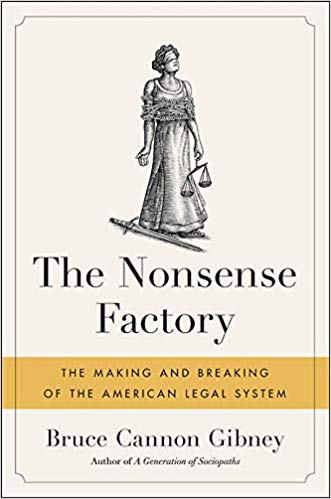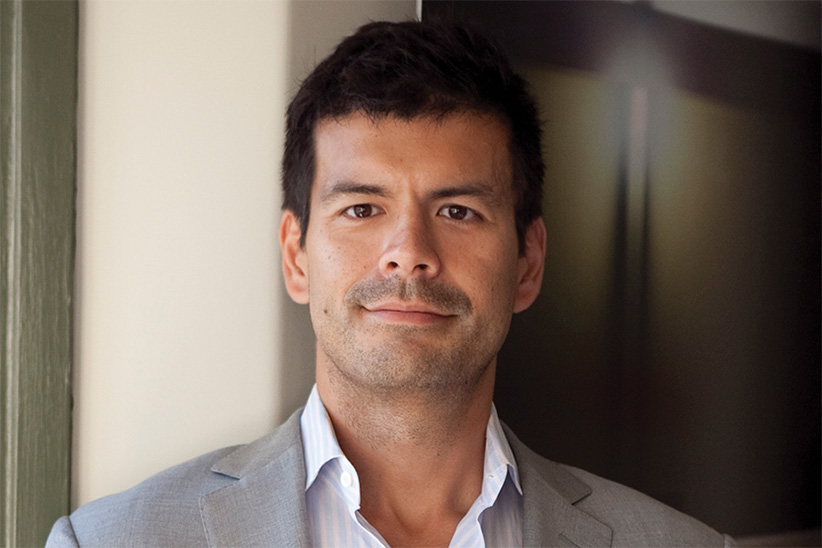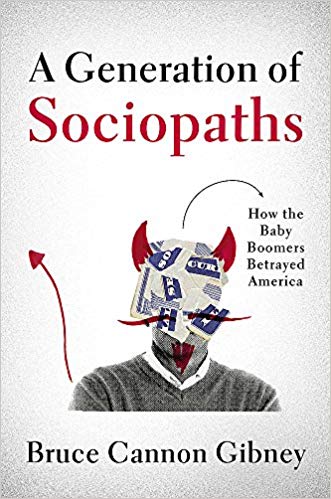The Nonsense Factory
The Silicon Valley nouveau riche are different from the rest of us; they are more grandiose
An abridged version of this essay originally appeared in Law & Liberty on July 29, 2019 as Lost in Nonsense (here). Thank you, Power Line! And Overlawyered.com (here)

Silicon Valley venture capitalist Bruce Cannon Gibney–who had the good fortune to be Stanford roommates with PayPal co-founder Ken Howery, allowing him to become an early investor and multi-millionaire while still in college–has written an ambitious book: a wide-ranging critique of the American legal system (civil, criminal, constitutional, and administrative), including the role of government and legal education. His prior book, indicting the Baby Boomer generation as sociopaths, [1] was similarly ambitious, and displayed the same snarky, over-the-top tone that pervades The Nonsense Factory (2019). Thus, when the author asserts, early on, that “It’s not only possible, but likely, that all three branches of government are controlled by criminals,” the reader isn’t sure if Gibney is being wryly ironic, facetious, deadly serious, or engaged in wild hyperbole.

Such is Gen X humor, I suppose. The trouble is, The Nonsense Factory is not intended to be funny—in contrast to his previous book, which was praised by some reviewers (amidst a generally lukewarm reception) for its “amusing style,” and for being “uproariously funny” and “deliberately provocative.” Unlike an anti-Boomer diatribe written for a receptive millennial audience, at over 500 pages The Nonsense Factory—subtitled “The Making and Breaking of the American Legal System”—plainly seeks to be taken seriously as a scholarly work, complete with voluminous endnotes and index. In this, it fails. Badly.

Gibney approaches the topic as if he were the first critic of the legal system to contend that the law has become “bloated and confused” and “overly complex,” that administrative law is lawless, that civil litigation has become overly-expensive and unpredictable, that we have a surfeit of criminal offenses, and so forth. Indeed, he asserts that “law has escaped a comprehensive critique” until he wrote The Nonsense Factory. This is silly. In fact, the American legal system has been subjected to withering criticism by a host of scholars, including Walter Olson (starting with The Litigation Explosion in 1991), Peter Huber, [2] Mary Ann Glendon [3], Frank Buckley, [4] Lester Brickman, [5] Richard Posner, [6] Philip Howard, [7] and many others [8], not to mention the specialized critiques of Philip Hamburger regarding administrative law [9] and Brian Tamanaha regarding legal education, [10] the growing body of work by criminal justice reformers, ad infinitum.
This just scratches the surface of the extensive literature. Constitutional law scholarship is a veritable cottage industry in legal academia. Ditto study of the executive branch by political scientists. Major trade associations are devoted to civil justice reform. No topic is as thoroughly mined by think tanks as “fixing” the legal system (civil and criminal). For example, legal policy is a major focus of the Manhattan Institute, and the Cato Institute sponsors a very active Project on Criminal Justice, led by Clark Neily. The notion that Gibney is the first person to formulate fulsome criticisms of the American legal system is breathtakingly myopic and self-absorbed, yet one looks in vain for any significant acknowledgement of other contemporary scholars’ work in The Nonsense Factory.
Gen Xers bearing a generational grudge may wish to discount the contributions of their elders, but ignoring them altogether evidences a fatuous conceit. As Gibney solemnly intones in the Preface, “My job here is to provide a more panoptic view.” One is reminded instead of Narcissus gazing at his own image in the water, enraptured.

Nor are Gibney’s insights particularly novel—or even insightful. His litany of complaints about the legal system is largely familiar, even if his conclusions—such as, “the whole of law is poisoned”; “America is basically lawless”; and “the world of criminal law is…unrestrained mayhem”—are frequently overwrought. Gibney is a lawyer, but spent little time in private practice before joining PayPal co-founder Peter Thiel’s hedge fund, launching his lucrative career in corporate finance. Undaunted, he brandishes his law degree like Sherlock Holmes’ magnifying glass, even though most of the “clues” he triumphantly discovers are in plain sight—or a reflection of his own left-of-center biases. (It quickly becomes apparent that Gibney is hostile to: Antonin Scalia; Bush v. Gore (2000); President Trump (who “no more understands the Constitution than a cat fathoms quantum mechanics”); judicial elections (heaven forbid the voters choose someone not approved by bar associations!); the Federalist Society; Alex Kozinski; law enforcement (“the thick blue line”); criminal prosecutors; prosecutorial elections; Citizens United (2010); John Yoo; and the cash bail system, among other fashionable targets.)
What distinguishes Gibney’s treatment of the subject is not his sagacity but his idiosyncratic perspective, which often leads to wildly-inconsistent positions. For example, most proponents of civil justice reform (especially pro-business advocates) favor the enforcement of now-commonplace contractual arbitration clauses. Gibney denounces them as “privatized justice,” “‘gotcha’ arbitrations,” and “rigged non-trials,” even though contractual provisions require consent, most arbitrators are experienced lawyers or retired judges, and arbitration procedures must comport with due process. Even libertarian critics of the legal system, who share Gibney’s objection to civil asset forfeiture and the doctrine of sovereign immunity (which limits the ability to sue errant law enforcement officers and for other government mistakes), sensibly support contractual arbitration.
More examples of Gibney’s quirky analysis: He seems to favor a “formalist” approach to law, with clear-cut rules and limited judicial discretion, yet he favorably cites figures such as Oliver Wendell Holmes, Jr. and Louis Brandeis, who were associated with the Legal Realism movement that ushered in the current model of law-as-social regulation. He rails against plea-bargaining in criminal cases (due to the presumed wisdom of juries as fact-finders and moral arbiters) without addressing the monumental increase in resources that would be necessary to process criminal cases (more than 95 percent of which are resolved by guilty pleas) without them.
And so on: Gibney complains about frivolous (and costly-to-defend) litigation, and wasteful, often pointless pre-trial discovery, and laments the lack of loser-pays, but has little to say about class action abuse, absurd liability rules (such as the ADA), contingent-fee arrangements, or speculative litigation financing. He devotes just two (noncommittal) pages to the critically-important issue of punitive damages. Gibney claims that the legal commentariat has failed to diagnose the grave ills of the legal system out of parochial self-interest or a fraternal “code of silence,” but he proves to be just as infatuated with lawyers as the insiders he derides. For example, he concludes that Congress is a mess in large part because of a decline in the number of lawyer-legislators! Likewise, he suggests that the rule of law would be improved by appointing more federal judges. Despite his iconoclastic façade, Gibney often evinces a naïve—even credulous–faith in the importance of lawyers.
Gibney is sharply critical of the current model of legal education, which, he complains, produces too many lawyers equipped with too few useful skills, many of whom flunk the bar exam. Gibney can’t make up his mind whether the bar exam is too hard, or simply an unfair barrier to entry, or whether law schools are deficient for admitting unfit students or failing to instruct them properly (and charging too much in the process). The answer turns out to be “all of the above,” but his critique ends anti-climactically with the suggestion that lower-tier schools be shuttered, and the middle tier should emulate trade schools (conferring a “JD-lite” degree on a new category of “super-paralegals”). The top tier law schools—which Gibney and his professional colleagues attended—could then become more selective, sparing graduates the indignity of failing the bar exam. (He has not a word to say about affirmative action.) How reducing the supply of lawyers is going to lower the cost of legal representation is never explained.
Gibney never minces words or seeks shelter in nuance: Our Anglo-American legal heritage, he avers, consists of “historical clutter accumulating since the thirteenth century.” The Second Amendment doesn’t protect Glocks because they didn’t exist in 1791. Judicial review is “radically democratic.” Tough-on-crime policies were a “fiasco.” “The conventional law firm model is a financially unstable, resource-destroying mess.” “Biased enforcement” explains the disparate rate of arrests, convictions, and incarceration for blacks. The War on Drugs constituted “neo-Puritan hysteria.” “Law is a grave-robber with eclectic tastes,” plucking “one trinket from the corpse while ignoring the other.”
Gibney’s irreverent—and often acerbic—style quickly becomes tiresome. Over the course of 13 verbose, repetitive chapters the bombastic prose hardens into an insufferable thicket of logorrhea—an extended Dennis Miller-style rant larded with pseudo-erudite, name-dropping references. The reader may discern that Gibney’s persnickety survey is not strictly guided by any conventional ideological compass—libertarian, liberal, conservative, classical liberal, etc. The overarching theme of The Nonsense Factory is elitist disdain for convention (and the law, after all, represents the highest form of convention), of a distinct milieu—that of smug, affluent technocrats. Silicon Valley is full of them.
Gibney excels at identifying problems, but falls risibly short on proposing workable solutions.For example:“Real improvement [in legal costs] requires reforming large swathes of the system’s structure, culture, and incentives.” Other proposed “solutions” include jury nullification, increased diversity, and consumer boycotts against bad corporate actors. Thin gruel, in other words.
What we really need, Gibney suggests, is an “Elon Musk of the law,” to disrupt the industry like Uber and Lyft did to transportation. [11] Ever the tech enthusiast, he effuses over the prospect of artificial intelligence transforming the legal industry, with—I’m not making this up–Alexa and Siri replacing Paul Clement and Clarence Darrow. [12] This is the height of hubris, without even a shred of self-awareness.
One critic dismissed A Generation of Sociopaths as (to paraphrase) a Gen Xer’s petulant whine. The Nonsense Factory falls into a distinctly different category, showcasing Gibney’s impressive versatility: it is a prolonged, self-indulgent—and unconvincing–harangue.
[1] A Generation of Sociopaths: How the Baby Boomers Betrayed America (2017).
[2] Liability (1988); Galileo’s Revenge (1991).
[3] A Nation Under Lawyers (1996).
[4] The American Illness (2013).
[5] Lawyer Barons: What Their Contingency Fees Really Cost America(2011).
[6] Overcoming Law (1995).
[7] The Death of Common Sense (1994); The Collapse of the Common Good (2001).
[8] E.g., Paul Craig Roberts and Lawrence M. Stratton, The Tyranny of Good Intentions (2000); Harold J. Rothwax, The Collapse of Criminal Justice (1996).
[9] Is Administrative Law Unlawful? (2014).
[10] Failing Law Schools (2012).
[11] Gibney ostentatiously mentions that he’s an investor in Uber and Lyft, betting that they may become “profit machines” like Google and Facebook.
[12] The Nonsense Factory 218-19 (2019). Elsewhere Gibney laments that “there’s no legal Amazon, with customer reviews and two-day shipping,” and refers to negotiated prison sentences as “trinkets to be auctioned on a legal eBay.”
































